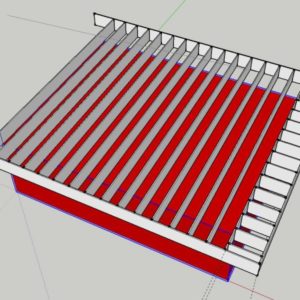I wonder about drains for a flat roof design, and am looking for some advice from pros who have built them.
In a climate with snow and ice on roofs, good drainage is paramount.
Many old wood-framed buildings exist here, that have flat roofs. Most of our downtown buildings are done that way. The roofs are built with parapets on front and sides, and slope to the rear, where they drain directly to gutters and downspouts.
A new residence is proposed with a flat roof, done with engineered trusses. There are overhangs, some quite large, that are handled with girder trusses hung from cantllevered commons.
We wish to have parapets everywhere, meaning that we either drain via scuppers, or through sumps in the roof.
I am thinking that the sump drains would be preferred, because we could bring the downspouts down hugging the house walls, below.
These roofs will be “hot,” their decks insulated from below with sprayed urethane foam, applied to the sheathing between trusses, with additional insulation atop done using rigid foam. Roofing with be membrane-type.
How steeply would you pitch these? What is called for in IRC 2006 section 905 (I don’t have the code book)?
Would you do sumps or scuppers? Explain why.
A rough concept of the trussed structure for a roof is attached. Depth, connectors, number of plies, etc., are all to be engineered by the truss supplier.





















Replies
I'd prefer scuppers 10-1 over roof drains. The scuppers can be made large enough so clogging is a near impossibility and if they drain into a leader head, a downspout clogging would not cause ponding on the roof.
http://www.quittintime.com/ View Image
"The scuppers can be made large enough"OK, that is true.Just that I have never seen them larger enough
Welcome to the Taunton University of Knowledge FHB Campus at Breaktime. where ... Excellence is its own reward!
I'd consider having electricty near each scupper for ice melt cables just in case.
I think it really helps to have a channel for drainage even if it is small.
Over time the channel gets bigger from water flowing past.
Will Rogers
If you go with roof drains install an emergency scupper several inches up your parapets for those 50 year storms when your drain is overwhelmed. The loading during these events is significant and the water can build up over the edges of your membrane.
I wouldn't want to get in that situation, but I did frame a house with a flat roof and parapets. Architect spec'd 4" roof drains with down spouts thru the exterior and interior walls. I don't think think he slept at a Holiday Inn Express.http://www.tvwsolar.com
We'll have a kid
Or maybe we'll rent one
He's got to be straight
We don't want a bent one
He'll drink his baby brew
From a big brass cup
Someday he may be president
If things loosen up
"the water can build up over the edges of your membrane."The membrane should carry to the top of the parapet wall
Welcome to the Taunton University of Knowledge FHB Campus at Breaktime. where ... Excellence is its own reward!
True. but my experience has been that everyone seems to relax when they are a foot or so off the deck. Roof top ac units and other protrusions get less attention, and the joint there the membrene meets side walls is suseptable - often the parapet gets covered with scraps. By that point they seem to be more worried about rain intruding than floods from below. I used to take the train quite a bit, which is a great way to see lots of flat roofs up close as the tracks run past buildings on embankments or bridges. I was always surprised at how many are completely flooded even in good weather.
Edited 8/2/2009 1:33 pm ET by fingersandtoes
This all does vary with climate and type of membrane too, but EPDM is easy to make right.Know what you mean about seeing some stuff from trains.Then there are the roofs that were designed and intended to pool several inches of water. Dealt with one like that once on a govt building.
Welcome to the Taunton University of Knowledge FHB Campus at Breaktime. where ... Excellence is its own reward!
"We wish to have parapets everywhere, meaning that we either drain via scuppers, or through sumps in the roof."
parapets all around are bad design in snow country
if they are an absolute requirement, the quality of the roofing product and the installation must be 110% perfect. That means you will pay extra for it.
scuppers will freeze and lead to ice damns and the damage that those roof glaciers cause, including added live loads on the structure, so plan for that. Use Heat tapes in the scuppers if you want, but those only work until they quit working or until somebody unplugs them or the breaker blows and never gets re-set.
Been there.
Never seen a sump on a roof myself. Never even heard of it, so I can't comment there.
A third option is the way I would go and that is for an internal drain system. nees careful install, but done right, they can work.
1/2" / 12" pitch is acceptable, 1/12 better.
The drains do need regular cleaning though. If the HO is not the sort who is disposed to take care of that, the same comments as on scuppers applies.
Welcome to the
Taunton University of Knowledge FHB Campus at Breaktime.
where ...
Excellence is its own reward!
Back in '03, we had a big snowstorm about these parts. The actual total was about 54", give or take, depending.
Lot's of us had some rather nasty gutter damage and such, but some of the flat roofed commercial buildings (the one story type), didn't so so well.
I don't know how they calculated their snow loads, but it was something to see the exterior masonry walls supporting the metal joists. Buckled about halfway up, to the outside and the roof fell down inside. Lines and lines of them.
I manage 3 homes on a very large estate in Mass. All 3 (one of them is my own home) have flat roofs, 2 have roof drains and one has scuppers.
While the idea of having a scupper work as an overflow in case of 50-100-200 year storms is nice I see nothing more than a nightmare making/keeping it water tite maintaining a good appearance. Multiple roof drains in cast iron draining down insulated interior walls works quite well and is very quiet. Sadly the archy placed skylights (about 30) all over a .06 rubber roof on the main house and that is where 95% of our leaks come from. I have my very good roofer inspect every year all of the flashing and caulking and this helps on paint and plaster repairs. Roof is just over 20 years old.
The barn has scuppers, 2 leaks in 20 years, both seam related. No skylights or penetrations.
Caretakers house has had 2 leaks in 20 years. Flashing and a bad boot for a vent. 1 skylight 60" square.
The problems for the roof drains are very rare but the baskets must be kept clean in the fall from leaves and crud. 2 winters ago we had about 12" of snow followed by 3" of rain. To say there was allot of water up there is an understatement. Water could not escape thru the baskets and snow fast enough. Needed to remove the baskets and plow paths for the water heading for the drains. I was standing in over 5" of water logged snow.
Send your roof design to the supply house and they will layout the design for the tapered insulation forcing water to your drains.
I'm not a fan of a ballast system because of the dirt they hold over the years. I prefer a fully adhered glue down roof.
The buildings are truss roofs.
great description and fully consistent with all my experiences
Welcome to the Taunton University of Knowledge FHB Campus at Breaktime. where ... Excellence is its own reward!
Gene
Do you realize that the way you show the framing there won't work without corbels to support that right overhang?
Those stubby joists making the OH on that side would need to come back inside by 2/3 their length and attach to a tripled joist or beam
Welcome to the
Taunton University of Knowledge FHB Campus at Breaktime.
where ...
Excellence is its own reward!
Thanks. You're right, that is easier.
I was thinking of all the outboard trusses as multiply girders, and engineered for the loadings. But we can readily change the scheme per your suggestion. This has yet to go to Mr Truss Engineer.
View Image
"A stripe is just as real as a dadgummed flower."
Gene Davis 1920-1985